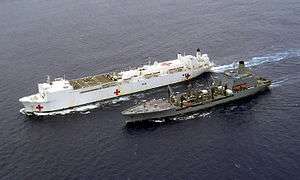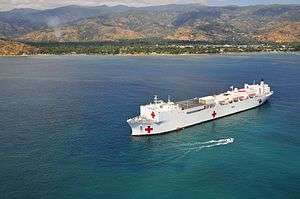USNS Mercy (T-AH-19)
 USNS Mercy leaving San Diego Bay, May 2008 | |
| History | |
|---|---|
| Builder: | National Steel and Shipbuilding Company |
| Laid down: | 12 June 1974 (As SS Worth MA-299) |
| Launched: | 1 July 1975 (in San Diego, California) |
| In service: | 8 November 1986 (to US Navy) |
| Homeport: | San Diego, California |
| Status: | in active service |
| General characteristics | |
| Displacement: | 65,552 tons[1] |
| Length: | 894 feet (272.49 meters)[1] |
| Beam: | 106 feet[1] |
| Propulsion: | two boilers, two GE turbines, one shaft, 24,500hp (18.3MW) |
| Speed: | 17 knots[1] |
| Complement: |
|
| Time to activate: | 5 days |



_aboard_the_Military_Sealift_Command_(MSC)_hospital_ship_USNS_Mercy_(T-AH_19)%2C_perform_a_cleft_lip_surgery.jpg)
The third USNS Mercy (T-AH-19) is the lead ship of her class of hospital ships in the United States Navy. Her sister ship is the USNS Comfort (T-AH-20). She was named for the virtue of compassion. In accordance with the Geneva Conventions, USNS Mercy and her crew do not carry any offensive weapons, though defensive weapons are available. Firing upon the Mercy would be considered a war crime.
Mercy was built as an oil tanker, SS Worth, by National Steel and Shipbuilding Company, San Diego, in 1976. Starting in July 1984, she was renamed and converted to a hospital ship by the same company. Launched on 20 July 1985, USNS Mercy was commissioned on 8 November 1986. She has a raised forecastle, a transom stern, a bulbous bow, an extended deckhouse with a forward bridge, and a helicopter-landing deck with a flight control facility. The Mercy class hospital ships are the second largest ships in the U.S. Navy Fleet by length, surpassed only by the nuclear-powered Nimitz-class supercarriers.[2]
Her primary mission is to provide rapid, flexible, and mobile acute medical and surgical services to support Marine Corps Air/Ground Task Forces deployed ashore, Army and Air Force units deployed ashore, and naval amphibious task forces and battle forces afloat. Secondarily, she provides mobile surgical hospital service for use by appropriate US Government agencies in disaster or humanitarian relief or limited humanitarian care incident to these missions or peacetime military operations.[3]
USNS Mercy, homeported in San Diego, is normally in reduced operating status. Her crew remains a part of the staff of Naval Medical Center San Diego until ordered to sea, at which time they have five days to fully activate the ship to a NATO Role III Medical Treatment Facility, the highest only to shore based fixed facilities outside of the theater of operations.[3][4] Like most "USNS" Ships, Mariners from the US Navy's Military Sealift Command are responsible for navigation, propulsion, and most deck duties on board.[1] Mercy is as of c.2012 part of MSC's Service Support Program. However, the "Medical Treatment Facility", or hospital on the ship, is commanded by a Captain of the Navy Medical Corps or Navy Nurse Corps.
Deployments
Philippine Training Mission (1987)
On 27 February 1987, Mercy began training while en route on a humanitarian cruise to the Philippines and the South Pacific. The staff included U.S. Navy, Indian Navy, U.S. Army, and U.S. Air Force active duty and reserve personnel; United States Public Health Service; medical providers from the Armed Forces of the Philippines; and MSC civilian mariners. Over 62,000 outpatients and almost 1,000 inpatients were treated at seven Philippine and South Pacific ports. Mercy returned to Oakland, California, on 13 July 1987.
Operation Desert Shield/Desert Storm (1990–91)
On 9 August 1990, Mercy was activated in support of Operation Desert Shield. Departing on 15 August, she arrived in the Persian Gulf on 15 September. For the next six months, Mercy provided support to multinational allied forces. She admitted 690 patients and performed almost 300 surgeries. After treating the 21 American and two Italian repatriated prisoners of war, she departed for home on 16 March 1991, arriving in Oakland on 23 April.
Operation Unified Assistance (2004)
USNS Mercy departed San Diego on 5 January 2005 en route to the tsunami-devastated regions of South East Asia, where she provided medical care to the victims of the disaster as part of Operation Unified Assistance, and further care as part of Theater Security Cooperation Program 2005. Combined, she provided 108,000 patient services, rendered by members of the Department of Defense, Project Hope, and the United States Public Health Service.
Pacific Partnership (2006)
USNS Mercy departed San Diego in 2006 as the inaugural deployment of Pacific Partnership, an ongoing Civic Assistance mission designed to "Prepare in Calm to Respond in Crisis". She visited several ports in the South Pacific Ocean including the Philippines, Indonesia, and Banda Aceh. The ship's primary mission was to provide humanitarian assistance to these countries, and its staff included several non-governmental organizations, doctors from the armed services of several countries, as well as active-duty and reserve military providers from many branches of the US armed forces.
Pacific Partnership (2008)
USNS Mercy departed San Diego on 14 April 2008 for "Pacific Partnership 2008", a four-month humanitarian and civic deployment in Southeast Asia and Oceania. Mercy, with her 900 officers and sailors, included 300 US health and construction experts. Partners participating in the mission included the nations of Australia, Canada, Chile, Japan, the Republic of Korea, New Zealand, and Portugal, as well as several non-governmental organizations.[5] Originally intended to visit the Philippines, Vietnam, the Federated States of Micronesia, East Timor, and Papua New Guinea, USNS Mercy was to be redirected to the Bay of Bengal to provide immediate assistance to victims of the cyclone in Burma, but relief efforts in Burma were called off. On 10 June, the humanitarian mission was temporarily suspended after one of its helicopters was shot at in the strife-torn southern Philippines area of Mindanao. Over the course of the deployment, Mercy would treat 91,000 patients, including performing 1,369 surgeries.
Pacific Partnership (2010)
On 24 February 2010, the Commander of the US Pacific Fleet announced that Mercy will be the lead vessel of Pacific Partnership 2010, a continuation of the recurring humanitarian mission to Southeast Asia and Oceania.[6] For Pacific Partnership 2010 Mercy visited Vietnam, Cambodia, Indonesia, and Timor Leste; treated 109,754 patients, and performed 1,580 surgeries.
Pacific Partnership (2012)
3 May 2012 saw Mercy depart San Diego once again for Pacific Partnership 2012,[7] the latest deployment of the Pacific Partnership series. In an effort to further expand the scope of the mission of "Preparing in Calm to Respond in Crisis", many more man hours of Subject Matter Expert Exchange (SMEE) with host nations, Veterinary Care, and construction projects were performed compared to past Mercy deployments, building the capacity of host nations to respond to regional disasters in a coordinated manner. The ship visited Indonesia, Philippines, Vietnam, and Cambodia carrying personnel not only from the Department of Defense, but also 13 partner nations and 28 Non-Governmental Organizations.[8]
Aftermath of Typhoon Haiyan (2013)
In mid-November 2013, Mercy was ordered to activate for Operation Damayan, the relief effort in response to the devastation caused by Typhoon Haiyan, which struck the Philippines on 7 November 2013. However, Mercy was deactivated before sailing.[9][10]
Rim of the Pacific (RIMPAC) (2014)
The US Navy announced that Mercy would be participating in RIMPAC 2014, a large multi-national Naval Exercise involving ships and personnel from 23 countries. In addition to providing real-world afloat acute medical and surgical care to personnel injured during the exercise, Mercy participated in multi-lateral Subject Matter Expert Exchanges with other military medical professionals. In addition, Mercy steamed with Peace Ark, the hospital ship from the People's Republic of China during phases of the exercise.[11]
Pacific Partnership (2015)
Ten years after the relief effort for victims of the Indian Ocean Tsunami, US Pacific Fleet announced that Mercy would once again participate in Pacific Partnership. Focusing on Subject Matter Expert Exchanges and Community Health Engagements, Pacific Partnership 15 looks to continue the mission of helping nations in the region "Prepare in Calm to Respond in Crisis". Countries hosting Mercy include Fiji, the Independent State of Papua New Guinea, Republic of the Philippines and Vietnam.[12]
Pacific Partnership (2016)
Celebrating 10 years of Pacific Partnership, US Pacific Fleet announced that Mercy would continue to participate in the ongoing series of Disaster Preparedness missions. Focusing on local Subject Matter Expert Exchanges, Pacific Partnership 16 continues to "Prepare in Calm to Respond in Crisis". Countries that have invited Mercy include Timor Leste, Malaysia, Indonesia, Republic of the Philippines and Vietnam.[13]
General characteristics
- Patient Capacity:
- Intensive care wards: 80 beds
- Recovery wards: 20 beds
- Intermediate care wards: 280 beds
- Light care wards: 120 beds
- Limited care wards: 500 beds
- Total Patient Capacity: 1000 beds
- Operating Rooms: 12
- Departments and Facilities:
- Casualty reception
- Radiological services including CT
- Main laboratory plus satellite lab
- Central sterile receiving
- Medical supply/pharmacy
- Physical therapy and burn care
- Intensive Care Unit
- Dental services
- Optometry/lens lab
- Morgue
- Laundry
- Burn Treatment
- Angiography
- Blood Bank
- Oxygen producing plants (two)
See also
References
- 1 2 3 4 5 "USNS Mercy (T-AH 19) Hospital Ship". Ship Inventory. Military Sealift command. Retrieved 31 August 2010.
- ↑ "Patient Care". Command Facilities. USNS Mercy. Retrieved 31 August 2010.
- ↑ "NATO Logistics Handbook: Chapter 16: Medical Support". nato.int. October 1997. Retrieved 13 October 2014.
- ↑ "USNS Mercy Deploys for Pacific". Navy News. 2 May 2008. Archived from the original on 2011-06-06.
- ↑ "Commander of US Pacific Fleet Announces Pacific Partnership 2010". United States Pacific Fleet. Retrieved 31 August 2010.
- ↑ "MSC hospital ship departs for humanitarian mission" (Press release). Military Sealift Command. 3 May 2012.
- ↑ "USNS Mercy returns following humanitarian mission in SE Asia" (Press release). Military Sealift Command. 14 September 2012.
- ↑ "USNS Mercy deactivated, not going to Philippines". CBS8 San Diego. 2013. Retrieved 13 October 2014.
- ↑ "23 Nations to Participate in World's Largest Maritime Exercise". US Navy.
- ↑ "10th Pacific Partnership mission prepares to renew regional ties". United States Pacific Fleet.
- ↑ "Nations Come Together, Finalize Plans for Pacific Partnership 2016". Commander, Western Logistics Group Pacific.
External links
| Wikimedia Commons has media related to USNS Mercy (T-AH-19). |